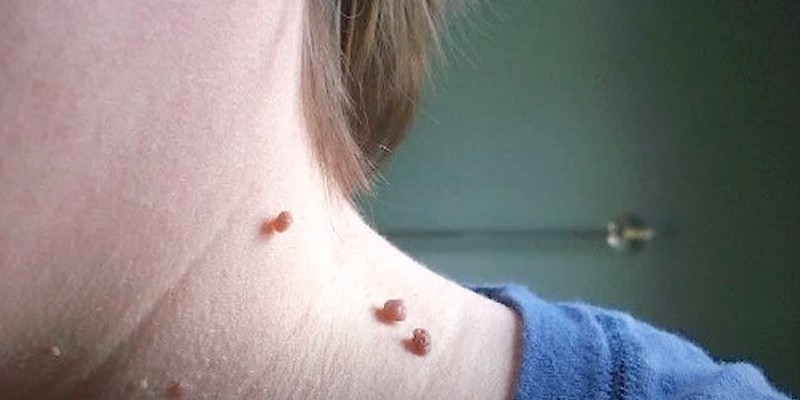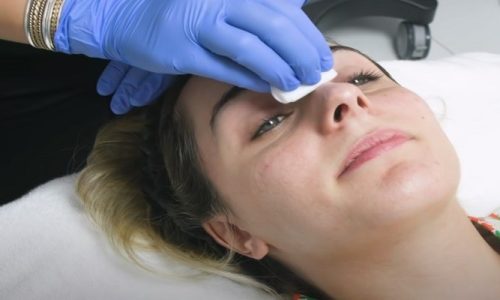Last Updated on May 4, 2025 by Jaclyn A. Neeley
Warts and skin tags are common skin growths that can appear on various parts of the body. While they may look similar to the untrained eye, they are distinct conditions with different causes, characteristics, and treatments. This article will explore the differences between warts and skin tags, their causes, symptoms, and the best methods for treatment and removal.
What Are Warts?
Warts are benign skin growths caused by the human papillomavirus (HPV). They are contagious and can spread through direct contact with an infected person or surface. Warts can appear anywhere on the body but are most commonly found on the hands, feet, and face.
Types of Warts
- Common Warts: Typically found on the hands and fingers, these warts have a rough, grainy appearance and may have black dots, which are clotted blood vessels.
- Plantar Warts: Found on the soles of the feet, these warts can be painful due to their location and the pressure from walking.
- Flat Warts: These are smaller and smoother than other types of warts and often appear in large numbers on the face, neck, or legs.
- Filiform Warts: These warts are long and thin, often appearing on the face around the mouth, eyes, or nose.
- Periungual Warts: Found around the nails, these warts can affect nail growth and cause discomfort.
What Are Skin Tags?
Skin tags, also known as acrochordons, are small, soft, benign growths that hang off the skin by a thin stalk. They are not caused by a virus and are not contagious. Skin tags are most commonly found in areas where the skin folds or rubs against itself, such as the neck, armpits, groin, and under the breasts.
Characteristics of Skin Tags
- Appearance: Skin tags are usually flesh-colored or slightly darker and can range in size from a few millimeters to a few centimeters.
- Texture: They are soft and smooth, unlike the rough texture of warts.
- Growth Pattern: Skin tags tend to remain stable in size and number, whereas warts can spread and multiply.
Causes of Warts and Skin Tags
Causes of Warts
Warts are caused by the human papillomavirus (HPV). There are over 100 different strains of HPV, and different strains cause different types of warts. The virus enters the skin through small cuts or abrasions, leading to the growth of warts. Factors that increase the risk of developing warts include:
- Direct Contact: Touching a wart on another person or on oneself can spread the virus.
- Weakened Immune System: Individuals with weakened immune systems are more susceptible to HPV infections.
- Moist Environments: Warts are more likely to develop in moist environments, such as public showers and swimming pools.
Causes of Skin Tags
The exact cause of skin tags is not well understood, but several factors are believed to contribute to their development:
- Friction: Skin tags often develop in areas where the skin rubs against itself or clothing.
- Genetics: There may be a genetic predisposition to developing skin tags.
- Hormonal Changes: Hormonal fluctuations, such as those during pregnancy, can increase the likelihood of developing skin tags.
- Obesity: Excess body weight can lead to more skin folds and increased friction, contributing to the formation of skin tags.
- Diabetes: People with type 2 diabetes are more prone to developing skin tags.
Symptoms and Diagnosis
Symptoms of Warts
Warts are generally painless but can cause discomfort depending on their location. Common symptoms include:
- Rough Texture: Warts have a rough, grainy surface.
- Black Dots: Common warts may have black dots, which are clotted blood vessels.
- Pain: Plantar warts can be painful due to their location on the soles of the feet.
Symptoms of Skin Tags
Skin tags are usually asymptomatic but can cause discomfort if they become irritated. Common symptoms include:
- Soft Texture: Skin tags are soft and smooth to the touch.
- Hanging Appearance: They often hang off the skin by a thin stalk.
- Irritation: Skin tags can become irritated or bleed if they catch on clothing or jewelry.
Diagnosis
Both warts and skin tags can be diagnosed through a visual examination by a healthcare provider. In some cases, a biopsy may be performed to rule out other skin conditions.
Treatment and Removal
Treatment of Warts
Warts can be treated using various methods, depending on their type and location. Common treatments include:
- Cryotherapy: Freezing the wart with liquid nitrogen causes it to fall off.
- Salicylic Acid: Applying salicylic acid helps to dissolve the wart over time.
- Laser Treatment: Laser therapy can be used to destroy the wart tissue.
- Surgical Removal: In some cases, warts may be surgically removed.
- Electrocautery: Burning the wart with an electric current.
Treatment of Skin Tags
Skin tags do not require treatment unless they cause discomfort or cosmetic concerns. Common removal methods include:
- Cryotherapy: Freezing the skin tag with liquid nitrogen.
- Excision: Cutting off the skin tag with surgical scissors or a scalpel.
- Cauterization: Burning off the skin tag using electrical current or a high-frequency laser.
- Ligation: Tying off the base of the skin tag to cut off its blood supply, causing it to fall off.
Prevention
Preventing Warts
To reduce the risk of developing warts, consider the following preventive measures:
- Avoid Direct Contact: Do not touch warts on yourself or others.
- Keep Skin Dry: Moist environments can promote the spread of HPV.
- Use Protective Footwear: Wear flip-flops or sandals in public showers and swimming pools.
- Boost Immune System: Maintain a healthy immune system through a balanced diet and regular exercise.
Preventing Skin Tags
While skin tags cannot be fully prevented, certain measures can reduce the likelihood of their development:
- Maintain a Healthy Weight: Reducing excess body weight can decrease skin folds and friction.
- Wear Loose-Fitting Clothing: Avoid tight clothing that can cause skin irritation.
- Practice Good Hygiene: Keep the skin clean and dry to minimize irritation.
When to See a Doctor
It is important to consult a healthcare provider if you notice any changes in the size, shape, or color of a skin growth, or if you experience pain, discomfort, or signs of infection. Additionally, if you are unsure whether a growth is a wart or a skin tag, a dermatologist can provide an accurate diagnosis and recommend appropriate treatment.
Conclusion
Warts and skin tags are common skin growths with distinct differences in their causes, characteristics, and treatments. Warts are caused by a viral infection and are contagious, while skin tags are benign growths often associated with friction and certain medical conditions. Understanding these differences can help in identifying and managing these skin conditions effectively. If you have concerns about skin growth, it is always best to consult a healthcare provider for an accurate diagnosis and appropriate treatment.
FAQs
Can I use wart remover on skin tags?
No, you should not use wart remover on skin tags. Wart removers contain strong chemicals designed for the hard surface of warts, which can damage the softer tissue of skin tags, leading to irritation, scarring, or infection. It’s best to use treatments specifically designed for skin tags or consult a healthcare professional for safe removal.
How do I know if I have a wart or a skin tag?
Warts are rough, raised bumps caused by the human papillomavirus (HPV) and are often found on hands and feet. Skin tags are soft, flesh-colored growths that hang off the skin by a stalk and typically appear in areas of skin folds and friction. If unsure, consult a healthcare provider for an accurate diagnosis.
What naturally kills skin tags?
Several natural remedies are suggested for skin tag removal, including apple cider vinegar, tea tree oil, and garlic. These methods aim to dry out the skin tag, causing it to fall off over time. However, scientific evidence supporting their effectiveness is limited, and they may cause skin irritation. Consult a healthcare professional before trying these remedies.
Can I cut off a skin tag with nail clippers?
Cutting off a skin tag with nail clippers is not recommended due to the risk of infection, bleeding, and scarring. If you choose to do so, ensure the tools are sterilized and the area is cleaned thoroughly. However, it is safer to have skin tags removed by a healthcare professional to avoid complications.
How can I prevent warts and skin tags from recurring?
To prevent warts, avoid direct contact with warts on other people or surfaces, keep your skin clean and dry, and avoid sharing personal items. For skin tags, minimize skin friction by maintaining a healthy weight and wearing loose-fitting clothing. Regularly check your skin and consult a healthcare provider for persistent or concerning growths.







